Orthopaedic surgery, a medical specialty focused on diagnosing, correcting, and treating disorders of the musculoskeletal system, has a rich and fascinating history. From ancient splints to high-tech joint replacements, the field has evolved dramatically over centuries, reflecting broader advancements in medicine, technology, and anatomy.
Origins in Antiquity
The roots of orthopaedic practice stretch back to ancient civilizations. Evidence of bone-setting has been discovered in Egyptian mummies, some dating as far back as 3000 BCE. Ancient texts from India, such as the Sushruta Samhita (circa 600 BCE), contain detailed descriptions of fracture management and joint dislocations. Hippocrates, the famed Greek physician (circa 400 BCE), contributed significantly to early orthopaedic techniques, particularly in treating spinal deformities and fractures using traction and splints.
The Middle Ages: A Period of Stagnation
During the Middle Ages, medical progress slowed across Europe, with much of the knowledge from antiquity lost or overshadowed by religious dogma. Nevertheless, some advancements were preserved by Islamic scholars, such as Avicenna, who translated and expanded upon Greco-Roman medical texts. Practical bone-setting continued, often performed by barber-surgeons and traditional healers rather than formally trained physicians.
The Birth of Modern Orthopaedics
The term “orthopaedics” was coined in 1741 by French physician Nicolas Andry, derived from the Greek words orthos (straight) and paideia (rearing of children). His book, L’Orthopédie, emphasized the prevention and correction of skeletal deformities in children, especially spinal curvatures like scoliosis.
In the 18th and 19th centuries, orthopaedic surgery began to take shape as a distinct medical specialty. Advances in anatomy, anaesthesia (introduced in the 1840s), and antiseptic techniques (pioneered by Joseph Lister in the 1860s) made surgery safer and more effective, allowing more complex orthopaedic procedures.
20th Century: The Golden Age of Innovation
The two World Wars catalysed massive progress in orthopaedic surgery. The high incidence of battlefield injuries prompted innovations in fracture treatment, prosthetic development, and surgical techniques. Surgeons like Hugh Owen Thomas and his nephew Sir Robert Jones made foundational contributions to trauma care and rehabilitation.
The mid-20th century saw the emergence of joint replacement surgeries. In 1962, Sir John Charnley revolutionized orthopaedic care with the development of the low-friction arthroplasty, a procedure for total hip replacement using acrylic bone cement and metal-polyethylene prosthetics. This breakthrough became a template for other joint replacements and is still influential today.
Spinal surgery also advanced significantly, with the introduction of techniques like spinal fusion, laminectomy, and eventually minimally invasive spine surgery. Paediatric orthopaedics gained prominence as well, focusing on congenital deformities such as clubfoot and hip dysplasia.
21st Century: Robotics, Biologics, and Personalized Medicine
Orthopaedic surgery in the 21st century continues to evolve rapidly. Innovations include:
- Minimally Invasive Surgery: Smaller incisions, less tissue damage, and faster recovery.
- Robotic-Assisted Surgery: Precision in joint replacement and spinal procedures.
- Biologics: Use of stem cells, platelet-rich plasma (PRP), and growth factors to promote healing and regeneration.
- 3D Printing: Custom prosthetics and implants tailored to individual anatomy.
- Digital Health: AI, wearable tech, and telemedicine enhance diagnosis, monitoring, and rehabilitation.
Conclusion
From rudimentary splints to robotic surgery, orthopaedic surgery has undergone a remarkable transformation. Driven by necessity, discovery, and technological progress, it has become a cornerstone of modern medicine. As innovations continue to emerge, the future promises even more personalized and effective treatments, helping patients regain mobility and quality of life with ever greater precision and care.
Independent Search Solutions Ltd is the predominate supplier of Ortho Talent in the Irish Market. If you work in Ortho Surgery (Scrub Nurse) or a Hospital based Physio and are looking for that break into Ortho Clinical Support we can advise you on the best career moves.
Get in contact today and see where your career can go.







